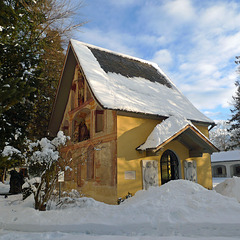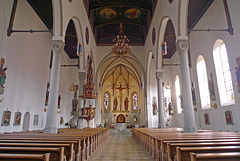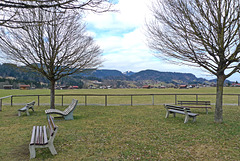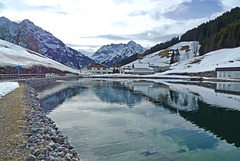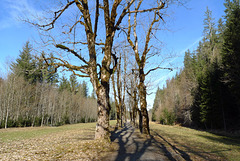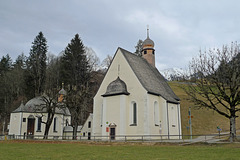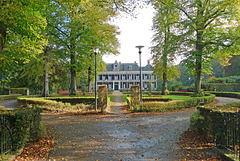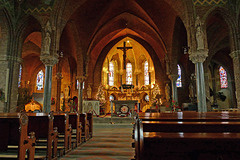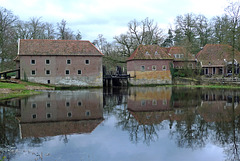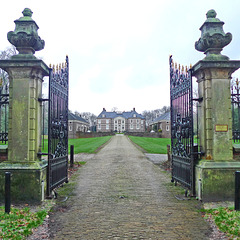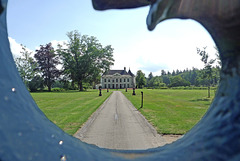Jaap van 't Veen's photos
Germany - Oberstdorf, Seelenkapelle
| |
|
|
|
The Seelenkapelle (Chapel of the Souls) is one of the few buildings in the center of Oberstdirf, which did not fall victim to the Great Fire of 1865. The chapel is located on the west side of the parish church - in the middle of the old abandoned cemetery - and has been used as a war memorial chapel since 1931. The entrance is therefore guarded by two martial soldiers.
The chapel was probably built in the late 15th century. An "eternal light" was donated to it in 1504. In 1524 it was mentioned as an ossuary. The amazing paintings with the sculptures in the niches on the north wall were created in the middle of the 16th century. The impressive Pietà in the interior is dating back to the early 40s of the 20th century.
The Seelenkapelle is of huge significance to the fallen soldiers from the war and is also considered as a memorial (PiP3). The chapel is the second oldest of the Oberstdorf chapels.
Germany - Rettenberg, Geratser Wasserfall
| |
|
|
|
The Geratser Wasserfall is a striking waterfall in the Kranzegger Bach . It is located south of Kempten and north of Sonthofen in the municipality of Rettenberg. The Kranzegger Bach flows through a green meadow landscape before dropping six meters from a wall in a small wooded area.
The waterfall got its name from the hamlet of Gerats, where it is located. As the waterfall is so hidden in the forest and at the same time a few kilometers away from well known villages, this natural wonder does not attract many visitors.
Germany - Oberstaufen, St. Peter und Paul
| |
|
|
|
The St. Peter und Paul - the catholic parish church of Oberstaufen - was built in 1389 on the ruins of a medieval collegiate church. In its turbulent past, the church saw further destruction when it fell victim to fire at the end of the 17th century and in the 19th century. The present church was built in the neo-Gothic style between 1859 and 1863.
The St. Peter und Paul impresses with a 65 meters high tower with foundations dating back to the 13th century, meter-high statues of the crucifixion group from the late Gothic period and a huge image of St. Christopher on the façade. The ornate pulpit inside the church was also built in the neo-Gothic style in the mid-19th century.
Germany - Oberstdorf, St. Johannes Baptist
| |
|
|
|
St. Johannes Baptist - the parish church of Oberstdorf - stands on the market square in the center of town. The tower with a height of 66 meters - the tallest in the upper Illertal - is the landmark of the town.
The year 991 is mentioned in chronicles as the start of construction of the parish church, but other sources report that this Romanesque church was consecrated in 1141. In 1865, two thirds of Oberstdorf fell victim to the the great fire, including the parish church in the middle of the village; only the surrounding walls and the burnt-out tower remained standing.
The reconstruction of the parish church took place in 1866. The walls of the nave, which were still standing and made of stone masonry could be used again; the nave was raised, extended and provided with a newly built choir. The church was finally reconsecrated in 1872.
Four altars, beautiful pictures and statues adorn the church. The high altar and the people's altar are in the choir room. On the left is the Pentecost altar and on the right the Christmas altar. The church also has a beautiful carved pulpit.
Germany - Oberstdorf, Breitachklamm
| |
|
|
|
The Breitachklamm (Breitach Gorge) was formed only during the last 10,000 years after the “Würm ice age”. Glaciers had eroded soft rocks, and hard rocks remained. When the glaciers had melted, the river Breitach had to grind its way through the hard rocks, over a distance of 2.5 km.
During these years the Breitach has cut a deep canyon into the rocks of the Bavarian Alps, almost on the border between Austria and Germany, just south of Oberstdorf. The most interesting part of the gorge is a couple of hundred meters long. On some places the steep walls are more than 100 meters high, where only very few spots ever get the sunlight.
There is a secured path along the river, which on the narrowest places has been cut into the steep wall of the canyon. All around is water running down the rocks, gurgles in tiny rivers across the hiking trail into the Breitach. On other place waterfalls are coming down from the overhanging walls. The further you enter the gorge, the scene turns into barren rocks with the noise of the powerful water rushing and tumbling metres below the walkway.
Winter 2024 Oberstdorf: Unlike on a previous winter-visit when the walls of the gorge were covered with glittering icicles, ice curtains and frozen waterfalls we were now surprised by waterfalls and a spray of fine droplets and the roaring Breitach beneath us. Water was really everywhere.
Germany - Oberstdorf
| |
|
|
|
The huge village meadow - Öschwiesen - of Oberstdorf is dotted with old barns. Being as flat as a pancake it is an ideal place for walking, biking and in winter for cross country skiing.
Winter 2024 Oberstdorf: No snow, no cross-country skiing, just walkers enjoying the sun and/or the magnificent views of the surrounding Allgäu mountains (snow picture see PiP3). Farmers had already spread manure on the pastures.
Austria - Kleinwalsertal, Rohrsee
| |
|
|
|
The Rohrsee is a water reservoir for the Heuberg ski area.
We passed this artificial lake on a hike along the Untere Höhenweg from the mountain station of the Heuberg lift to Mittelberg. From the path/road, we had beautiful views of Kleinwalsertal (see PiPs).
Austria - Kleinwalsertal, Hoher Ifen
| |
|
|
|
The Hoher Ifen - also called Hochifen - is a 2.230 meters high summit of the Ifen plateau, which is part of the Allgäu Alps. It lies on the border between Austria and Germany and can only be accessed by road from Germany. Hoher Ifen is part of the European Watershed, where water is separated between the North Sea (Rhine River) and the Black Sea (Danube).
This Dolomite-like rock formation with its steep walls is the natural landmark of the Kleinwalsertal. In winter the mountain plateau is an impressive backdrop for the Ifen ski area.
Germany - Oberstdorf, Trettachtal
| |
|
|
|
Trettachtal (Trettach Valley) is one of Oberstdorf’s valleys, which are characterised by glacial drift from the latest ice age. The valley glaciers from the large side valleys gradually crept south, forming the scenery that is visible today. As the glaciers receded, watercourses formed the current valleys, among them the beautiful Trettachtal. The Trettach stream originates south of Oberstdorf near the Trettachspitze and is about 14 km long.
Nowadays the valley - almost car free - offers a more or less level, yet beautiful walk. We often made a round trip during our winter holidays in Oberstdorf. First following the river and passing the hamlets Gruben and Dietersberg, back along the golf course, the frozen Moorweiher and the historic Moorbad swimming pool.
Winter 2024 Oberstdorf: This winter, everything was completely different. There was no snow at all to be seen and the high temperatures made it more spring than winter. It resulted in different pictures than 'normal' (see snow photo of around the same spot in PiP 5).
Germany - Oberstdorf, St. Loretto-Kapellen
| |
|
|
|
The Loretto-Kapellen (Loretto chapels) are a complex of chapels and a fountain on the outskirts of Oberstdorf. It consists of three individual Roman Catholic chapels. The Loretto chapels refer to the Italian pilgrimage site of Loreto near Ancona and are the end point of the Way of the Cross, which starts at the parish church in the village.
The Appachkapelle is the smallest and oldest Loretto chapel. The octagonal building was built in 1493. It is the origin of the entire complex. Today, the church houses a simple marble altar adorned with a wooden sculpture. The little chapel also offers frescoes from the time of its construction (PiP2).
Just outside the chapel stands the Marienbrunnen , which has probably existed since the beginnings of the pilgrimages (PiP1).
The most beautiful and largest chapel is the Kapelle Maria Loretto . It was built when the Appachkapelle became a popular pilgrimage chapel in the 17th century (between 1657 and 1677) and could no longer cope with the large number of pilgrims. It houses the miraculous image of Mary (PiP3 and 4).
The Josefskapelle was built in 1671 on a cross floor plan and consecrated in 1685. This chapel used to form the actual end of the Way of the Cross (PiP5).
Nederland - Ruinen, Echtens Paradijs
| |
|
|
|
Echtens Paradijs (Paradise of Echten) is a 1,200-hectare nature reserve in the Ruinen forestry area. Originally virgin and inaccessible, the area was planted with coniferous forests in the 1930s; nowadays, these are increasingly being replaced by broad-leaved forests. Another part of the area consists of heathland, shifting sands and fens.
Nederland - Huis te Echten
| |
|
|
|
Huis te Echten (Echten Manor) is a so called havezate (fortified house, homestead, court or farm of a nobelman). As early as the 13th century, there is mentioned a hofstat (homestead, large house with land) belonging to Volker van Echten, a descendant of the viscounts of Coevorden. It is not certain whether this hofstat was the later Huis te Echten . Parts of the current house probably date from the 15th century.
A moat around the building dates from before 1700. The house was probably converted into a house around a courtyard with two wings in the early 18th century. Due to a later renovation in 1808, many older building elements disappeared. Later, parts of the building were added on the north and south sides.
Huis te Echten was inhabited until 1971 by the families Van Echten and Van Holthe tot Echten. After the death of the last Mr Van Echten, his daughter Anna Geertruida married Rudolph Otto van Holthe in 1802, who started calling himself Van Holthe tot Echten. Their descendants continued to inhabit the manor.
The house was restored from 1976 to 1981. From 1975 to 2023, Stichting Visio - a foundation for visually and mentally handicapped people, was housed in Huis te Echten .
Nederland - Denekamp, Sint-Nicolaaskerk
| |
|
|
|
The history of the Sint-Nicolaaskerk (Church of Saint Nicholas) is dating back to the year of 1276, when Denekamp was mentioned as a parish for the first time. The church is one of the few religious buildings erected in the region of Twente in the 13th century that is still largely preserved.
The medieval part of the present church consists of a single-bay. As far as this region of the Netherlands is concerned it is the oldest preserved single-bay church, though no longer completely intact.
The medieval parts were built of sandstone from nearby Bentheim. The tower was built against the church in the second half of the 15th century (or early 16th century). Later there were many more enlargements, the last one started in 1910 with the construction of a new transept and choir and apse, which were built with bricks. Architect ‘Te Riele’ also gave the tower - which had been fully closed - an entrance in a pseudo-Romanesque style.
After the reformation the church was used by the protestant minority for about two centuries. In 1809 King ‘Lodewijk Napoleon’ gave back the church to the Catholics. The church is still used for services.
Nederland - Denekamp, Watermolen Singraven
| |
|
|
|
Singraven is an estate near the town of Denekamp. It includes a manor, a garden, a water mill, a carriage house and a number of farmhouses. The estate offers a versatile landscape with forests, lanes, fields, meadows, marshes and the ever-present river Dinkel.
The water mill has been part of Landgoed Singraven (Singraven Estate) since 1448. The mill consists of an oil mill (no longer in operation and partly demolished, nowadays housing a restaurant), a corn mill and a saw mill. The corn mill and saw mill are still in operation and can be visited. The mill is run - mostly on Saturdays during summer time - by volunteer millers.
Watermolen Singraven is the last water-driven undershot sawmill in the Netherlands. Its water supply comes from the small river Dinkel, which rises in the town of Holtwyck in Nordrein Westfalen (Germany).
The mill has three water wheels, each with a diameter of 5.5 metres. The left wheel against the restaurant is from the former oil mill. The oil mill was demolished in the early 20th century, so the wheel is the only remaining part. The middle wheel is from the corn mill and the right wheel from the sawmill.
Nederland - Denekamp, Huis Singraven
| |
|
|
|
Singraven is an estate near the town of Denekamp. It includes a manor, a garden, a water mill (dating back to1448), a carriage house (1868) and a number of farmhouses. The estate offers a versatile landscape with forests, lanes, fields, meadows, marshes and the ever-present river Dinkel.
Huis Singraven (Singraven Manor) has a rich history. In 1381, the estate is first mentioned as an agricultural farmstead Hof ten Singraven ; property of the bishop of Utrecht. In 1398 the house came into the possession of a family who fortified it into a manor in 1415. After being owned by several families, the estate eventually came into the possession of Willem Frederik Jan Laan. This private owner was the last resident of Huis Singraven .
Mr Laan commissioned several substantial renovations and restorations, including a neo-classical façade. During the period he lived in the house, he amassed a huge art and antiques collection. Mr Laan gave ownership of the estate to the “Edwina van Heek Foundation” in 1956 under the condition that everything should continue to exist in its original state.
Huis Singraven has limited opening hours and can only be visited by a guided tour.
Nederland - Huis Almelo
| |
|
|
|
Huis Almelo (Manor Almelo) is first mentioned in the 13th century when Egbert of Almelo left in his will the legacy of his castle in Almelo on 6th June 1297. What the house looked like at the time is unknown. Later, around 1652, the original house was demolished and replaced with a new building by Zeger van Rechteren. By the end of that year the new brick-built house was ready for habitation.
Unfortunately all this beauty was to be short-lived due to the occupation of the troops of tishops Troops from Munster 1665-1666, when they inavded the Netherlands. This occupation led to considerable damage being caused to the home and after the troops departed, the slow job of restoring this once impressive home to its former glory. Commissioned by count Adolf Frederik the restoration work began and between 1883 and 1885 the house was fully restored and renewed.
To this day, Huis Almelo remains in the hands of the Van Rechteren Limpurg family. Being still inhabited it is not possible to vsit the manor and one has to be satisfied with looking at the manor from the entrance gate.
Nederland - Denekamp, Huis Singraven
| |
|
|
|
hFF: the main picture was taken through a fence, which is the frame of the image
Singraven is an estate near the town of Denekamp. It includes a manor, a garden, a water mill (dating back to1448), a carriage house (1868) and a number of farmhouses. The estate offers a versatile landscape with forests, lanes, fields, meadows, marshes and the ever-present river Dinkel.
Huis Singraven (Singraven Manor) has a rich history. In 1381, the estate is first mentioned as an agricultural farmstead Hof ten Singraven ; property of the bishop of Utrecht. In 1398 the house came into the possession of a family who fortified it into a manor in 1415. After being owned by several families, the estate eventually came into the possession of Willem Frederik Jan Laan. This private owner was the last resident of Huis Singraven .
Mr Laan commissioned several substantial renovations and restorations, including a neo-classical façade. During the period he lived in the house, he amassed a huge art and antiques collection. Mr Laan gave ownership of the estate to the “Edwina van Heek Foundation” in 1956 under the condition that everything should continue to exist in its original state.
Nederland - Haarzuilens, Kasteel de Haar
| |
|
|
|
Kasteel de Haar (The Haar Castle) is one of the most visited castles in the Netherlands. Originally it was named Het Huys te Haer . However the current Gothic fairy-tale castle was built between 1892 and 1912 with incorporation of the large 15th century ruins of the original castle.
Kasteel de Haar was first mentioned in 1391 along a blind arm of the river Rhine. Originally the owner was a member of the “Van de Haar” family. In 1449 the castle became property of the “Van Zuylen” family through the marriage between Josyna van de Haar and Dirk van Zuylen. Several families owned the castle until 1890 when baron “Etienne van Zuylen van Nijevelt”, inherited Kasteel de Haar (by then the castle had been in a ruinous and desolate state for almost two centuries). In 1887 Etienne had married the French baroness Helene de Rothschild (member of the extremely wealthy De Rothschild family), which enabled him to rebuilt the castle.
In 1892 the rebuilding of Kasteel de Haar started under the direction of the well known Dutch architect Cuypers. It's his interpretation of the ‘medieval’ castle one can see today. The interior was rebuilt in an un-Dutch luxurious style, it was equipped with electricity and the former courtyard, covered with a large roof, was turned into an imprerssive central hall. The interior is luxuriously decorated with a large but incoherent collection of valuable antiques from all over the world.
In 2000 the ownership of the castle was transferred to “Stichting Kasteel de Haar”. This foundation worked to transform the place into a museum and event center. The castle has 200 rooms - although not all of them can be visited. A couple of rooms are arranged with realistic displays to show how the castle would have looked like in his days of parties. Nowadays Kasteel de Haar is (almost) open daily for visitors.
Jump to top
- ipernity © 2007-2024
- Help & Contact
|
Club news
|
About ipernity
|
History |
ipernity Club & Prices |
Guide of good conduct
Donate | Group guidelines | Privacy policy | Terms of use | Statutes | In memoria -
Facebook
Twitter

